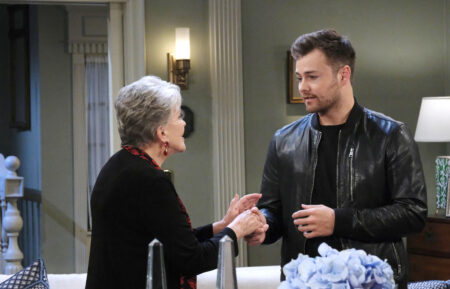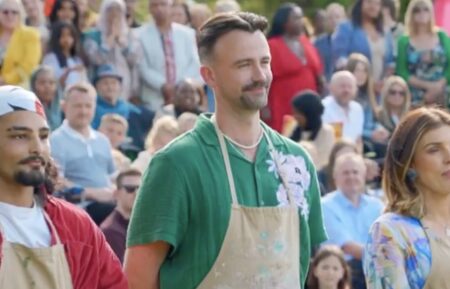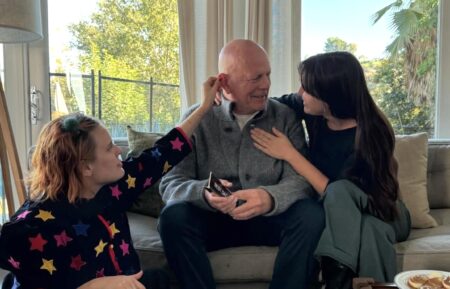Nathan W. Pyle & Dan Harmon’s ‘Strange Planet’ Is a ‘Wholesome’ Version of ‘Rick and Morty’
Rick and Morty co-creator Dan Harmon and executive producer Steve Levy have teamed with creator Nathan W. Pyle to turn his viral webcomic Strange Planet into the next big adult animated hit.
Based on the New York Times #1 bestselling graphic novel and social media phenomenon of the same name, Strange Planet (premiering August 9 on Apple TV+) showcases a humorous and perceptive look at a distant world where “existence is absurd,” according to the trailer. The show features these relatable blue beings as they explore the oddities of everyday human traditions.
TV Insider’s exclusive clip of Strange Planet above shows an advertisement for Actual Airlines, which highlights our bizarre history and relationship with airplanes. With this series, which stars Tunde Adebimpe, Demi Adejuyigbe, Lori Tan Chinn, Danny Pudi, and Hannah Einbinder, the absurdity of the world is central.
In an interview with TV Insider, Pyle gives a brief history of the webcomic, its similarities with Rick and Morty, and the heart and sincerity underneath all the preposterous humor.
What’s the story behind creating a concept like this?
Nathan W. Pyle: Great question. Well, I would say it all started with [the] comic I made. I made one new comic every day for 365 days from February 2019 on, and I really was kind of building it as I went. I knew these beings were slightly different than what you’d see on Earth. I knew they were experiencing things that were familiar. But about eight months into the comic, I went and I talked to Dan Harmon and Steve Levy and said, “You know, I think this could be a world that people could discover in a TV show.”
They were intrigued by the fact that these beings were pretty honest with each other. There’s no deception. There’s no cynicism. What if a conflict arises from honesty? What if we actually have these beings that are kind of leveling with each other at the beginning of the episode rather than the end, as is the case with most sitcoms? I think that was really the concept. It was pretty elastic. But it was a world full of emotionally vulnerable beings who were honest and sincere, and conflict would arise from various situations in which they were honest together.

Apple TV+
I’ve seen the comic online for some time now. For those unfamiliar with the original comic, can you explain how the initial webcomic turned into a viral sensation?
I wanted to make a webcomic, so I would often do one-off comics [and] draw little comics here and there. But the first one I drew of this, it got the kind of reaction that made me realize, “Oh, people really liked this idea. They liked the visuals.” In this case, they were just some beings cleaning up their home before their friends arrived, and it involved essentially hiding all their possessions and making the place look as if no one lived there. And that’s a common aspect of being a human: You want to make sure your home looks like no one lives in it before anyone comes in. I think there was an interesting combination there that I realized with this whole visual defamiliarization and this warmth that these beings show to each other. … But I think combining it with warmth and combining it with emotional honesty was part of what I really wanted to create in this comic.
So I think it caught on with people. Obviously, the palette was memorable, and that helps. And so I did one a day for so long that people kind of came to expect it, and as you said, immediately, I saw that same comment over and over. I was probably six months or a year in, and people said, “This has been going on for several years, right?” And I say, “No, this is actually pretty new. I just started.” So I think part of that surprise was probably in the fact that I did so many, one a day for so long. It probably just created this huge backlog for people that many people thought had been around for a long time, but it’s pretty new still.
How were you able to strike a balance between absurdity and sincerity?
You know, I would credit Dan Harmon and Steve Levy, especially [their] experience with Rick and Morty or with Community. There are some episodes even of Community, just talking way back, where this is so absurd, but at the same time, I’m really rooting for these characters. And I think that’s such a tough balance to strike that Dan and Steve especially know how to strike. It’s very silly at the same time as it’s very meaningful, and your heart is in it with them. So I think that was fun. I think that, to me, was one of the most interesting parts of learning from them, that you don’t have to separate silliness from sincerity. Those two concepts can coexist. And I think they coexist in this show and the shows they’ve made before.
What were some things you could finally do or convey in the series that you couldn’t in the original webcomic?
I think the notion that they don’t have names, [they] kind of just exist, that notion exists in the webcomic. But I think the idea and the significance of that begins to materialize more in the show. Beings are able to change; beings are able to evolve more easily when there isn’t a name attached to them. I think that’s an interesting idea. In a world without names — imagine a world where all the beings go to therapy; that’s kind of what Strange Planet is: They all go to therapy, they’re all expressing their emotions with vulnerability but also with creativity and how they use language. That is an interesting world. And I think that gives opportunity to a more free and transformational atmosphere for everyone.
How was the anthology format decided for television?
We decided on a kind of a hybrid approach when it came to an anthology. We wanted it to be somewhat anthological, but then we wanted to have some recurring characters and see them off in a way that we were curious about where they go in the final moments of the season. I think the approach here was, well, it’s called Strange Planet, we want to start with Strange Planet, we don’t want to start with, you know, here’s the story of blah, blah, blah. This is a strange planet. And this is a planet full of beings. And you just start to get a sense that there are many different beings you could follow.
If one lived on Strange Planet, you could follow any one of these beings into a different atmosphere, a different universe, or storyline. So we just happen to follow a few of them and see where they end up. I think that really was crucial because it was true to the comic that there was no main character, and then, in the show, that’s exactly what we did. We said, “Alright, we don’t want it to feel like there’s a main character whose face we put on the poster. We want it to feel like this is just a planet full of beings whose lives are intriguing. And yet, we may meet entirely new beings. And in the next episode, well, who knows?”

Apple TV+
What was the decision behind the designs and everyone looking identical?
I think in the same way that I was making these beings somewhat different immediately; you can tell that they’re not quite the “typical sci-fi aliens.” I always call them beings because I think we’re visiting their planet. We’re the visitor here, viewing them. When I look at them as blue, there are some media that think of extraterrestrial beings as blue, but it’s not necessarily the most typical approach. I think there’s something relatable about blue; it’s the color of our sky, it’s something that we see constantly. And I think there’s something really beautiful about the notion that when we look in the sky, there are beings out there that color.
I think there’s just something fascinating to me about the fact that we live in space. We certainly aren’t alone. I think the latest images from deep space show that there are far too many galaxies for us to be alone. So I think that’s an interesting part of this, that the beings have some connections to our own vision of the universe. And I think when you see their world, it’s their eyes and their mouths that are their biggest features. That’s where the emotion really comes from. They’re just the eyes and the mouth. They’re showing their emotions more than anything.
Since you worked with Dan Harmon on the series, can you touch on some of the similarities and differences between Strange Planet and Rick and Morty?
I think one writer called Strange Planet a gentler Rick and Morty. I think that gentleness is evident in that Dan wanted it to be that way. We wanted more than anything to create something that was wholesome and gentle and yet absurd and strange, humorous but also heartfelt. That was crucial to what we were trying to make. When you think about Rick and Morty, Dan’s ability to weave stories about family and about loss and about regret into the most wacky storyline… I think there’s a unique ability Dan has there in that show, and obviously, working alongside him to make this show, we knew we had that level of skill that could pull off a unique feat here. So we’re really proud of what we made. It’s a unique approach to a show, and I think it wouldn’t have been possible without someone who’s made something like Rick and Morty and Community, among other things Dan has made.
Strange Planet, Series Premiere, Wednesday, August 9, Apple TV+









